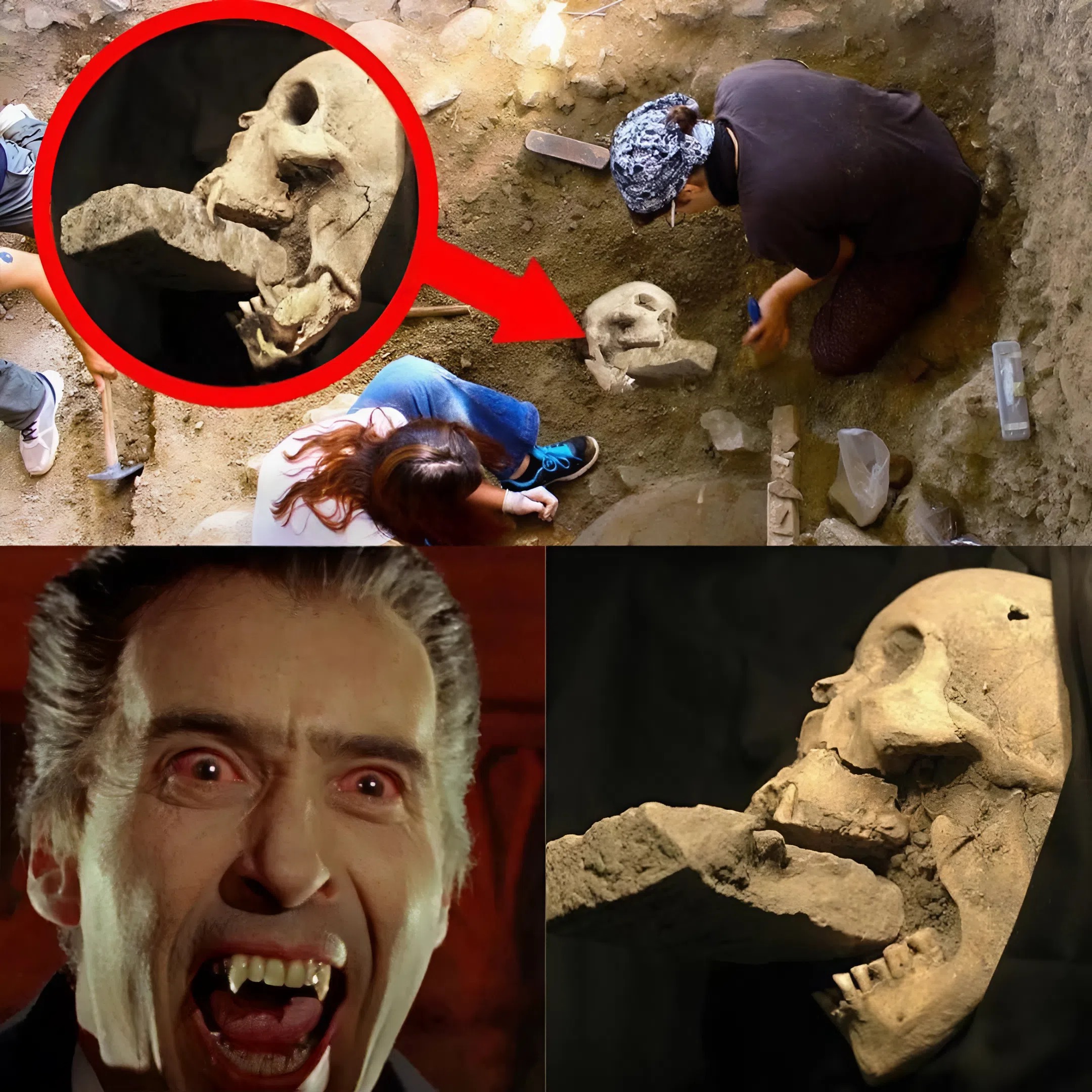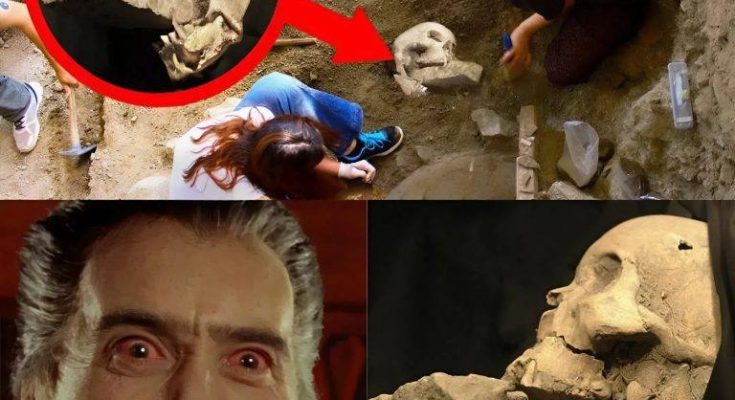Beneath the fog-drenched cemeteries of Eastern Europe, where the soil is thick with centuries of fear and folklore, archaeologists are uncovering graves that challenge everything we thought we knew about myth and mortality. These are not ordinary burials. Inside them lie skeletons pinned by iron stakes, jaws clamped shut with bricks, and stones placed deliberately upon the chest as if to restrain a restless heart. They speak of a time when panic eclipsed reason, when the living took extraordinary measures to prevent the dead from rising. And as modern science begins to decode these rituals, the line between legend and history grows hauntingly thin.
The Uneasy Sleep of the “Restless Dead”
The earliest so-called vampire burials in Europe date back to the Middle Ages, particularly in regions of modern-day Poland, Romania, Bulgaria, Serbia, and the Czech Republic. These were lands haunted by superstition, where unexplained deaths, plagues, or strange illnesses were often attributed not to microbes but to malign forces that seeped from the grave. In the absence of medical knowledge, people reached for explanations rooted in tradition and terror: certain corpses, they believed, refused to stay dead.

Across rural communities, tales of the strigoi in Romania or the upir in Slavic cultures were shared with genuine dread. These were not glamorous creatures of the night; they were shadows of one’s neighbor, a relative, or a recently deceased villager believed to linger between worlds. When crops failed, livestock sickened, or families died in clusters, suspicions turned toward the graveyard. The dead, it was feared, were feeding on the living.
In this context, burial customs became a battleground—an attempt to secure peace both for the departed and for the terrified communities they left behind.
Archaeological Evidence of Fear
Excavations over the last 30 years have brought to light remarkable and unsettling practices meant to “neutralize” potential revenants. Each method is a physical manifestation of belief:
Stakes Through the Body
Contrary to popular imagination, the stake was not always driven through the heart. In many cases, stakes were hammered through the legs or pelvis, anchoring the body to the grave. The purpose was clear: immobilization. A spirit might try to rise, but its body—bound by iron—would remain trapped in the soil.
Bricks or Stones in the Mouth
Perhaps the most chilling practice is the placement of bricks, stones, or even sharp metal in the mouth of the deceased. Archaeologists call these “anti-vampire occlusions.” The idea was symbolic and practical: by sealing the jaws, the dead could not bite, speak spells, or consume the living. Some burials show the skull forcibly fractured to ensure the object remained lodged in place.
Heavy Stones on the Chest
Large rocks pressed onto the chest or abdomen served a dual purpose: to halt any supernatural reanimation and to prevent the “vampire” from drawing breath. In folk belief, respiration—even slow, corpse-like respiration—was associated with unholy life. Weighting the body was a way of suppressing that possibility.

Decapitation and Separation of Limbs
In various sites from Romania to Slovakia, skeletons show signs of post-mortem decapitation. The skull was often placed between the legs or beside the torso. By separating the head—the seat of identity and consciousness—from the body, villagers sought to dismantle the corpse’s agency. Similar logic applied to severed hands or feet: if the deceased could not walk or grasp, it could not harm the living.
Plague, Panic, and the Seeds of Myth
For centuries, these grisly scenes were interpreted purely as superstition. But modern forensics, DNA sequencing, and soil chemistry are revealing deeper, more complex motivations behind vampire burials.
Many remains show evidence of cholera, tuberculosis, anthrax, or unidentified bacterial infections. These diseases ravaged small communities rapidly and mysteriously. Without germs to blame, villagers feared spiritual contamination. In some sites, archaeologists discovered that “vampire” corpses were individuals who died first during epidemics—those suspected of bringing misfortune.
Other remains show signs associated with catalepsy or premature burial—a horrifying but real possibility before the advent of reliable death confirmation. When families later unearthed a grave and saw scratch marks inside a coffin or blood around the mouth (natural results of decomposition), fear metastasized into myth. The dead, they believed, had tried to escape.
The myth of the vampire may therefore originate not from imagination alone, but from very real medical phenomena misunderstood by pre-scientific societies. Supernatural explanations provided structure, logic, and even comfort in the face of inexplicable tragedy.
The Blurring of Myth and Material Reality
As scientists dig deeper, the gulf between legend and history collapses in surprising ways. Vampire folklore was not uniform; it evolved differently in each region based on cultural, ecological, and social pressures.
In Poland, for example, cemetery sites in Drawsko revealed “deviant burials” that included sickles placed across the neck—objects designed to decapitate the corpse should it rise. DNA tests of these individuals showed they were not outsiders or criminals, as once believed, but ordinary villagers. The fear of vampirism was not about condemning the marginal; it was about protecting the community.
In Bulgaria, a 700-year-old skeleton—nicknamed “the Sozopol vampire”—was found pierced with an iron rod. It drew global attention, not only because of the dramatic burial but because historical records described two local nobles with reputations for dark magic. As archaeology meets literature, speculation grows: were certain individuals feared not in death but in life?
Romania, too, offers tantalizing links between folklore and forensic evidence. Some excavated bodies were burned after burial—an act reserved for suspected strigoi. In medieval records, entire villages participated in such rituals. Today, burned bone fragments allow scientists to reconstruct sequences of events that once belonged only to oral legend.

The Social Function of the Vampire
Beyond their eerie rituals, vampire burials tell an even more profound story about human psychology and social order. Fear of the undead often arose during times of instability—war, famine, plague, or rapid cultural change. In those fragile moments, communities sought explanations for suffering, and the vampire became a scapegoat, a vessel for anxieties that could not be named.
These rites also served a practical function. By performing them, villagers reaffirmed their collective identity and exerted control over the unknown. Rituals—however macabre—helped restore stability.
The vampire, therefore, was less a monster and more a symbol: of grief, fear, illness, and the fragile line between life and death.
Modern Science, Ancient Nightmares
Today’s archaeologists are using advanced tools—radiocarbon dating, spectroscopy, isotopic analysis, and genome sequencing—to reconstruct the lives and deaths of those branded as vampires. Soil samples reveal traces of pathogens. Bone chemistry identifies nutritional stress or long-term illness. Genetic data hints at hereditary diseases that altered appearance, such as porphyria or wasting syndromes, which may have fueled superstition.
But even as scientific explanations emerge, they do not dispel the power of the myth. Instead, they enrich it. Every discovery underscores how deeply intertwined physical reality and imaginative fear have always been. The vampire myth, in this light, is not merely superstition—it is humanity’s attempt to understand suffering, mortality, and the unsettling mysteries of the body.
The Enduring Allure of the Undead
Why do these archaeological finds still fascinate us? Perhaps because they echo questions that linger across centuries:

What happens after death?
How do we confront what we cannot understand?
Why does fear so easily become ritual?
The graves unearthed today are windows into a world where myth was woven into daily life, where terror shaped ceremony, and where the dead were both loved and feared. They remind us that belief is powerful enough to leave physical marks in the earth.
The more scientists excavate, the clearer it becomes: vampires are not merely creatures of fiction but reflections of the darkest corners of human experience. They embody plague, grief, uncertainty, and the desperate desire to make sense of death.
And so, as archaeologists continue to lift stones from ancient chests and uncover iron that once bound restless limbs, they are not just exhuming skeletons. They are unearthing the fears of generations—fears that, in many ways, still walk with us.

